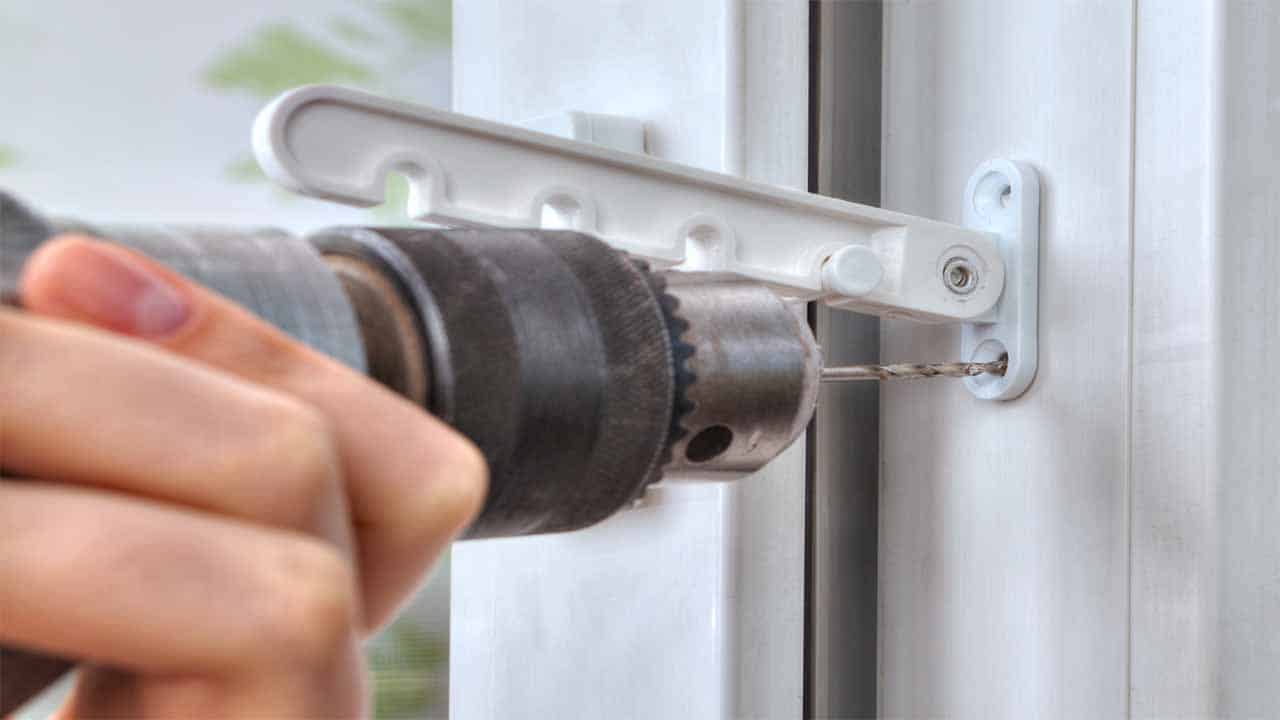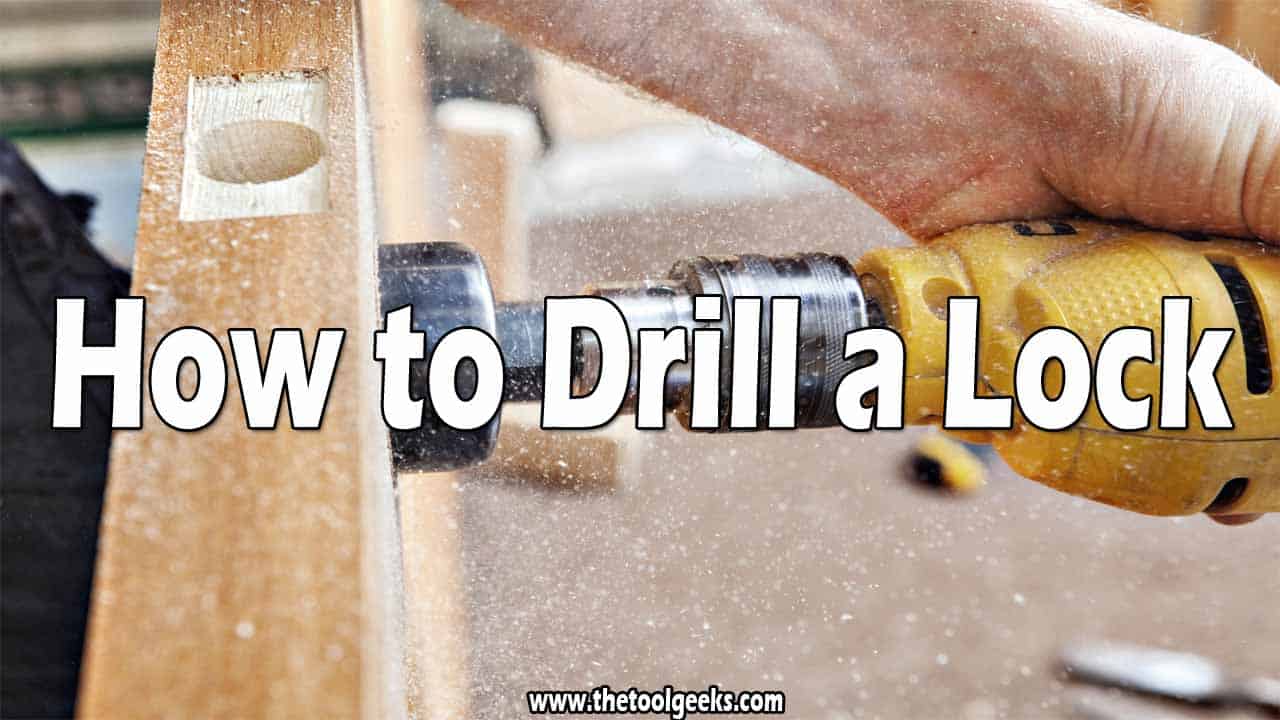How to Drill a Lock (7 DIY Steps)
TheToolGeeks.com is a participant in the Amazon Services LLC Associates Program and other affiliate advertising programs. We may earn from qualifying purchases. (Learn More).
A lock is a device used for keeping doors, windows, lid, and other types of entrance closed or fastened. It is operated by a key- whilst closing and opening. Locks could be electrical or mechanical and apart from keys, they could be operated with a fingerprint ID, keycard, security token, RFID card, and so on.
There are different types of locks and each has different methods of fastening them. Some even go as far such that some cannot be unlocked unless secret information- such as numbers, letters, or Morse code, is supplied.
Suppose, you misplaced your key, or forgot the passcode to your lock, you might need to drill the lock in order to gain entry into your home or wherever it is.
Drilling into locks can be a bit difficult and it is usually the last option to resort to when the key or password to a particular lock has been misplaced.
This is because inappropriate drilling of the lock can cause permanent damage to the lock cylinder. Hence, it is important to have a foreknowledge of lock drilling before venturing into one.
If you are a DIY, or you have little experience drilling locks, check out this article, as it will guide you towards the process of drilling locks.
Jump To Page Contents:
How to Drill a Lock
Take a Survey
Before resorting to drilling a lock, you must have ascertained that there is no other alternative for you other than drilling it. Drilling a lock would destroy it and you would need a new lock. So before drilling, make sure it is the only way out.
Also, taking a survey entails studying the lock properly to determine what type of drill would be needed. There are different types of locks and they do not all have the same drilling method, hence, the survey would assist you as regards the type of drill you would be needing.
If the lock is on the outside of the house, patrol the house’s perimeter, examine the doors and windows and see if there is a way you can get it without drilling the lock.
Besides, taking a survey will help you to know what type of lock you are about to drill. Is it a tubular lock, or a basic tumbler lock, or other types of lock? After the survey, you can now decide if you would have to call a locksmith expert to drill the lock for you or if you would be able to drill it yourself.
If the lock has been programmed with an alarm system, try to disable the alarm before making an attempt to drill it.
Related Read — How to Drill Through Metal?Gather Your Equipment
To start drilling, you need to gather your equipment around, as it might be stressful having to always search for a particular when it is needed. The tools can come in a variety of formats, shapes, and structures. Some of these tools could be manually hand-held tools, while some could be electrically powered tools.
Regardless of the type of tool you would be using, ensure they are all available before you start drilling. Since the method of drilling lock in this article is for homeowners, you would not be needing many sensitive or industrial tools. Just the normal, basic tools will do.
Here is a list of some of the important items you would need to drill a lock:
- Lubricant: The function of the lubricant is to reduce or remove the friction that might occur during the drilling process. It is usually in form of synthetic oil.
- Power drill: This is the life of the drilling process. Without the drill, no form of drilling would be possible. You would need a variable speed power drill that is in perfect working condition.
- Drill bits: Drill bits are pointed mouth steel, which the drill is attached to. They are available in different sizes. So far, the masonry, high-speed steel, and titanium nitride bits have proven to be the best bits for drilling.
- Screwdriver: Once the lock has been broken- after drilling is done, you would need a screwdriver- probably a flat-head screwdriver that can fit the keyspace or hole punch of the lock.
- Container: Once drilling is completed, you would need a plastic container to collect the filings that might have been collected during the drilling process.
Attach a drill bit
The first step to take in the drilling process is to attach a bit to your drill. This should not be a problem since you already have the tools available. The bit could be of any size; say a 1/8-inch drill bit or ¼-inch drill bit. Any size of the drill bit.
Create a Guidance Hole
To be able to drill through the pin tumblers effectively, you need to create a guidance hole. To do this, use a hammer to create a point above the key space– it will serve as a pathway during drilling. The point should be located directly below the shear line– the dividing line between the inner and outer cylinder of the lock.
In case there is a bit of difficulty finding the right place to create a guidance hole, you should consider buying a lock-drilling template.
Drilling the Lock
Since you have created a guidance hole, drilling the lock should not be much hectic. Firstly, drill a hole through the lock cylinder and this will automatically force the first pin on the lock to be opened. Then you continue that same process for the remaining five or six pins.

With each opening of each, you will feel more resistance through the handling of the drill bit. Then as the bit cuts through the pin, you will notice that the resistance tends to reduce. Maintain a steady tempo, go slowly, and do not exert too much pressure. Do not attempt to rush through it, slow and steady does it.
Should the drill binds in the process of drilling, pull it out of the lock and remove the excess metal fillings that might have been created in the process of drilling. If it does not bind, continue drilling gently.
Applying too much force or rushing while drilling the lock might cause the drill to jam or even, break down the drill bit. Now, in case it becomes a bit hard or difficult for the bit to drill through the pins, apply the lubricant.
The lubricant would help to reduce friction and make drilling easier.
Ensure you maintain the drill level, to avoid drilling through unnecessary parts.
Related Read — Corded vs Cordless DrillsChange the Bit
After drilling for a while, the drilling point would have gotten bigger and wider, hence you need to change the bit to a slightly bigger one. Say, a ¼-inch bit size or a larger one. Change the bit and attach it to your drill, then continue drilling the lock.
Turn The Lock Mechanism
The next thing to do is to use the blade of the flat-headed screwdriver to turn the lock mechanism as you would with a key. If the lock mechanism turns, that means you have drilled the lock perfectly. If however, it does not turn, that means you would have to destroy the entire lock cylinder.
It is only on rare occasions that the lock mechanism would not turn. If you experience such, here is what you should do.
Foremost, change the drill bit to a ¾-inch size and drill the whole lock area. Drilling the entire lock area will let you have access to the lock mechanism that refused to turn and you can now break it.
Quick tips and Precautions
In a bid to reduce the impediment you might encounter while drilling a lock, here are some tips to assist you. Likewise, there is a list of precautions you might need to take; before, during, and after drilling the lock.
- As insignificant as it might seem, ensure you have a bottle of lubricant nearby. Just so in case, your drill bit starts to get stuck in the entrance hole.
- Never use too much pressure on the lock; go easy and drill the lock open, or go hard and end up destroying the whole lock cylinder.
- Drill straight! Once you start drilling, never make an effort to bend or twist your drill to an angle. Doing so could damage other parts of the lock.
- Use a variable speed drill bit. A variable speed drill bit will help in regulating the speed of the drill bit while drilling and it has enough strength to chew down metal, steel, and iron.
Frequently Asked Questions (FAQ)
Do I Need an Expert to Drill a Lock?
The answer to this depends on the type of lock you want to drill. Some locks can easily be drilled without needing the service of an expert while can be drilled by any homeowner just by following the steps highlighted in this article.
Is Re-keying the Same as Drilling a Lock?
Drilling a lock and re-keying are two different terms. Drilling a lock entails disabling the lock mechanism in a particular lock system. While re-keying is simply a process where the lock cylinder of a lock system is pulled out and fixed with new pins to change the key.
Related Read — How to Drill Through Plastic?Is There Any Protective Gear to Wear While Drilling?
Not that much hazard is related to drilling a lock, but to be on a safer side it is advisable to get a pair of protective glasses or eyewear to use. This will prevent the metal fillings extracted from the drilling from getting into your eyes.
How Can I Improve the Life Span of My Lock?
One thing you should do to increase the longevity of your lock is to avoid over-tightening it. Over-tightening locks is the reason most locks are destroyed most of the time. Safety is important, but do not over-tighten the lock.
Tightening it such that the cap or coin door does not move loosely is enough. Overtightening not only reduces the life span of the lock, but it can also lead to damage of the tumblers and in a long run- break the lock.
The Lock Mechanism Seemed Jammed, What Should I Do?
If the wrong keys or foreign objects are inserted into the keyspace, the lock mechanism will pass it through. If however it becomes lodged, the lock mechanism will jam up. Once this occurs find all means possible to remove the foreign object else, you might have to start for a total replacement of the lock.
Related Read — How to Drill Into Siding?Conclusion
With all certainty, this article has provided everything you need to know about how to drill a lock — right from the time you decide to drill it until the moment drilling is completed. Clear explanations have been made and you have all need in this one piece.
Though it may require parting with a little cash but calling professionals will increase the effectiveness of the drilling, as they are more competent and experienced. Professionals would also likely make the drilling fast, neat, and precise.
Whichever decision you make, one important thing to note is the type of lock you are using because attempting to drill a lock with ball bearings or anti-drill pins might later lead to spending a huge amount on replacement.
At the end of the day, you might later have to pay experts to double the amount for a job you could have done yourself.
Lastly, the method of drilling explained in this article is for the conventional locks. Locks that are used at home, in offices, shops, and so on. However, this article may not serve you well to your satisfaction if your type of lock is the one used in banks, special vaults, and so on.
Amazon and the Amazon logo are trademarks of Amazon.com, Inc, or its affiliates.

